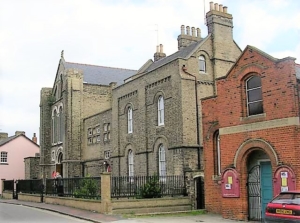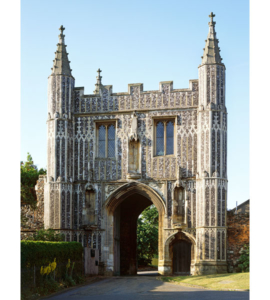
St James the Less and St Helen
Which Essex town boasts a church that shares an architect with London’s best-known Jesuit church; an early link with the Society of Jesus through the aunt of one of the most famous English Jesuits; and the origins of a ship that transported Jesuits imprisoned under the Elizabethan regime to freedom? If you don’t know, then you can now take a tour of ‘Catholic Colchester’ to find out about more about a town that may not be famed for its religious history, but nonetheless played a significant role in the shaping of the Reformation and in fighting against the brutalities of it.
In this anniversary year of the Reformation, the Colchester Catholic Heritage Group, the Shrine of Our Lady of Walsingham and the Museum Service in Colchester Castle will be putting on the first tour on 25 May 2017. The tour itinerary will also be included from now on in the pilgrimage route from Colchester to Walsingham.

St John’s Abbey Gatehouse
At the end of 1539, the Benedictine Abbey of St John in Colchester, considered to be the fourth largest abbey in England, was under threat from Henry VIII’s assault on the monasteries. Thomas Audley, Lord Chancellor of England, had raised concerns in a letter to Thomas Cromwell that the loss of the Abbey would seriously affect the poor who relied on the monks for provision of food, shelter and healthcare. Cromwell had drafted new policies whereby the provision of all of these needs would be met by civil society rather than the religious orders, but Audley had witnessed small uprisings in his native Essex that worried him, indications of the fears and loyalties that would divide Colchester should the monastery be closed. Audley had been given the Manor of Berechurch by the Abbey at an earlier date in the hope that he would be able to prevent the closure of the Abbey itself, but this wasn’t enough for Cromwell: the Abbey was closed and the Abbot’s execution on 1 December 1539 was brutal.
The Manor of Berechurch passed on Lord Audley’s death in 1544 to his brother, Thomas, a widower who had recently married again. Thomas’s new bride, Katherine Southwell, was the aunt of Robert Southwell SJ, and a devout Catholic. She stood against Elizabeth I by having Mass said in her home, and there are records of her involvement in the trafficking of priests, and her own son, to Douay in France. There are indications, too, that the Audleys facilitated the arrival from the continent of a number of priests.
Another Jesuit link with the town would be generated years later, in the Januarys of 1584 and 1585, when it was a Colchester vessel, the Mary-Martin, which transported Jesuits and other priests away from their imprisonment in the Tower and Marshalsea. And after the first post-Reformation Catholic church to be built in Colchester was completed in 1837, its architect, Joseph John Scoles, would go on to design the Church of the Immaculate Conception, Farm Street.
Tourists will have the opportunity to visit Scholes’s Colchester church, St James the Less and St Helen, along with several pre-Reformation sites: St John’s Abbey Gatehouse (all that remains of the Abbey), the remains of the first Christian church in England (St Helena’s, built in the time of the Roman occupation), the Church of the Holy Trinity (built in 1000), and the ruins of St Botolph’s Priory. Colchester Castle will then host afternoon tea and two brief talks, followed by an opportunity to look at medieval Catholic artefacts on display in the Castle Museum.
Future tours can be arranged for individuals or groups by request.
